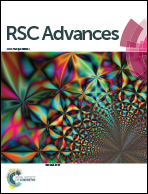A targeted metabolomics approach to characterize acetogenin profiles in avocado fruit (Persea americana Mill.)†
Abstract
Lauraceous acetogenins are fatty acid derivatives with an odd-carbon aliphatic chain found in avocado (Persea americana Mill.). These compounds display a wide range of bioactivities that makes them candidates for use as antimicrobial and proapoptotic agents in the food industry and against cancer cells respectively. Existing knowledge about its metabolism in planta is scarce. This work quantifies eight different acetogenins accumulated in fruit tissues (peel, seed, and pulp) from 22 avocado cultivars to sample the existing variation using a targeted metabolomics approach. Multivariate analyses uncovered correlations among acetogenins present in fruit tissues and their chemical backbone that allowed a proposal for classifying them in three families (Avocatins, Pahuatins and Persenins). The seed acetogenin profile differed from that of the pulp and peel, which while different in concentration (peel accumulated low acetogenin amounts), had the same profile. Acetogenins from samples of known origin were also separated by variety using descriptive Linear Discriminant Analysis (LDA), and a chemotaxonomic model was generated via predictive LDA and was tested on samples from unknown origin. This work effectively sampled acetogenin contents and profile variability in seed (1.09–8.33 mg per g FW), peel (0.22–12.5 mg per g FW), and pulp (0.49–9.58 mg per g FW) from avocado fruit, as well as provides a putative classification to seven avocado cultivars. Results from this work show that the eight acetogenins followed are produced in all 22 avocado cultivars, which points to conserved metabolism among avocado plants.


 Please wait while we load your content...
Please wait while we load your content...